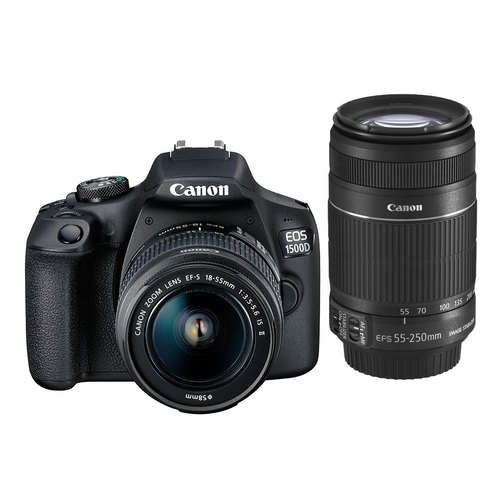







Canon EOS 250D DSLR Camera with 18-55 Lens
Cameras
Key Features
- UHD 4K24p Video and 4K Time-Lapse Movie
- 3.0" 1.04m-Dot Vari-Angle Touchscreen
- 24.1MP APS-C CMOS Sensor
- DIGIC 8 Image Processor
Overview
Defined by its notably sleek form factor, the black Canon EOS 250D is a versatile DSLR offering an ideal mix of stills and video capabilities. Featuring a 24.1MP APS-C-format CMOS sensor and DIGIC 8 image processor, high-resolution stills and UHD 4K video recording are possible, along with a wide ISO 100-25600 sensitivity range to suit working in a variety of lighting conditions. In-camera 4K time-lapse movie creation is also possible for creatively depicting subjects over time. Benefitting the imaging attributes, the sensor's design also facilitates Dual Pixel CMOS AF, which uses phase-detection autofocus for quick, accurate, and smooth focusing performance when recording movies or shooting stills in live view. When shooting stills using the optical viewfinder, a 9-point phase-detection system is used for quick and accurate focusing in a variety of shooting scenarios.
Within the compact body design, a large 3.0" 1.04m-dot touchscreen LCD is featured for intuitive settings control and live view monitoring, and it uses a vari-angle design to permit easier viewing from high and low working angles. Additionally, built-in Wi-Fi is available for quick and convenient pairing with a smartphone or tablet for wireless image sharing, and Bluetooth is also featured for image sharing to and remote camera control from a mobile device.
24.1MP APS-C CMOS Sensor and DIGIC 8 Image Processor
Both a 24.1MP APS-C CMOS sensor and DIGIC 8 image processor are used to deliver high sensitivity and fast camera performance to suit both stills and video applications. A flexible native ISO 100-25600 range suits working in a variety of lighting conditions, and the processing capabilities minimize noise for notable clarity. The processor also enables up to 5 fps continuous shooting as well as UHD 4K video recording and a 4K time-lapse movie mode.
UHD 4K Video Recording
In addition to stills recording, the SL3 also supports UHD 4K24p video recording, as well as Full HD and HD recording. Video recording is benefitted by the inclusion of Dual Pixel CMOS AF and the Movie Servo AF focusing functions, as well as the touchscreen design of the LCD monitor for intuitive control. Movie Digital IS also helps to steady recordings by minimizing the appearance of camera shake across five axes for smoother footage. Additionally, an external microphone jack is incorporated in the body design for greater control over your recorded sound.
Employing the video capabilities, a dedicated Time-Lapse Movie mode can also be used to creatively depict subjects over a longer span of time. Interval settings between 1 second and 60 minutes are available for between 2 and 3600 consecutive frames. These individual frames can then be automatically compiled into a 4K or Full HD video file for seamless playback.
9-Point Phase-Detection AF and Dual Pixel CMOS AF
Benefitting stills shooting with the optical viewfinder, a 9-point phase-detection autofocus system provides quick and precise focusing in difficult lighting conditions. The center point is also a cross-type for enhanced accuracy and speed.
When recording video or shooting in live view, a Dual Pixel CMOS AF system is employed that offers smooth and fast focusing performance in a similar manner to how a camcorder acquires focus. This system integrates two separate photodiodes within each pixel to provide a broad and dense network of phase-detection gathering elements across a majority of the image sensor to reduce focus hunting for faster, more direct control of focus placement. When working with still imagery, this focusing system works to acquire focus quickly and accurately, making it ideally suited to shooting and tracking moving subjects so that critical focus is attained with each shot. Eye Detection AF can also be employed to prioritize focus on a recognized subject's eye. When shooting video, a Movie Servo AF mode offers smooth and natural focusing when changing from different subjects or different distances within the scene, as well as the ability to specify tracking sensitivity, AF speed, and Face Tracking priority. Benefited by the Touch AF system, rack focus is possible simply by touching elements within the scene on the touchscreen in order to change focus in an intuitive manner. Subject tracking in movies is also heightened due to the Dual Pixel CMOS AF system's ability to recognize subjects and maintain focus when working within changing or cluttered scenery.
Body Design and Wireless Connectivity
- Large 3.0" 1.04m-dot touchscreen LCD provides an intuitive method for controlling focusing points, navigating menus, and reviewing imagery. This screen also features a vari-angle design to better enable working from high and low angles.
- Optical pentamirror viewfinder serves a clear means for eye-level shooting.
- Built-in Wi-Fi allows for easy wireless sharing of both photos and movies to a linked mobile device.
- Bluetooth permits linking a smartphone or tablet for quick image sharing between devices as well as remote control capabilities.
- Included LP-E17 rechargeable lithium-ion battery provides approximately 1630 shots per charge when working with the viewfinder, or approximately 350 shots per charge when working in live view.
Other Camera Features
- Creative Assist makes it easy to adjust camera settings and see the effects in real time, making it more straightforward to adjust brightness, contrast, and saturation effects and see how the resulting image will look.
- Feature Assistant and Shooting Mode Guide can be used to explain and illustrate the camera's various shooting modes in order to become more familiar with all of the capabilities.
- Smooth Skin mode offers five levels of skin smoothing to help reduce blemishes and make subjects' skin appear soft.
- Picture Style: Auto, Standard, Portrait, Landscape, Fine Detail, Neutral, Faithful, Monochrome, and User Defined 1-3
- Scene Modes: Portrait, Smooth Skin, Group Photo, Landscape, Sports, Kids, Close-Up, Food, Candlelight, Night Portrait, Handheld Night Scene, HDR Backlight Control
- Creative Filters: Grainy B/W, Soft Focus, Fish-Eye Effect, Water Painting Effect, Toy Camera Effect, Miniature Effect, HDR Art (Standard/Vivid/Bold/Embossed)
- Language Support: English, German, French, Dutch, Danish, Portuguese, Finnish, Italian, Ukraine, Norwegian, Swedish, Spanish, Greek, Russian, Polish, Czech, Hungarian, Vietnamese, Hindi, Romanian, Turkish, Arabic, Thai, Simplified/Traditional Chinese, Korean, Malay, Indonesian, and Japanese.






























